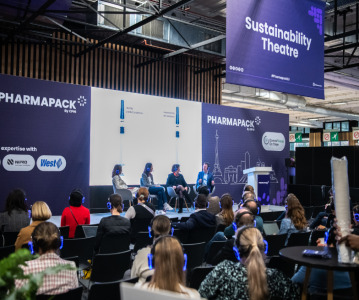Biomanufacturing: a future shaped by evolving markets, technology and global events

Gareth Macdonald
The coronavirus pandemic has impacted biopharmaceutical manufacturing and is likely to continue to do so for years to come. But the pandemic is not the only thing changing how the industry goes about making medicines.
Perfecting the art of biomanufacturing is like aiming at a moving target. Advances in processing technologies and methodologies have given drug companies new tools to improve product quality and reduce production costs. Likewise, evolving regional markets and the shifting regulatory landscape have prompted industry to reimagine all aspects of the supply chain, from production through storage and shipment to distribution.
These trends, combined with manufacturing challenges still to be addressed, will dictate what the biopharmaceutical facility of the future looks like.
COVID-19
The SARS-CoV-2 virus has had a profound impact humanity in 2020. Millions of people worldwide have died and millions more have fallen ill, and the toll continues to grow. Efforts to slow the spread of the virus have seen billions confined to their homes.
All industrial sectors have experienced disruption – from the food sector, which has seen meat processing plants emerge as viral hotspots, through to the aviation and automotive industries which have seen sales plummet.
The biopharmaceutical industry has been hit particularly hard. The pandemic has severely disrupted active pharmaceutical ingredient (API) and finished product supply chains while simultaneously increasing demand for medicines of all types.
From a biomanufacturing perspective, the impact of COVID-19 has been significant and wide-ranging, according to Simon Sprague, Partner at Boston Consulting Group.
“There are a number of ways in which COVID-19 has impacted biopharma manufacturing, most pressingly planning to be able to supply the previously unforeseen demand for vaccines and, to a lesser extent, at least in terms of likely volume, therapeutics,” he says.
According to the World Health Organisation, (1) 155 SARS-CoV-2 vaccines are in preclinical testing and 47 are in clinical trials. One of the most advanced candidate vaccines is BNT162b2 (2). Interim analysis released by to developers Pfizer and BioNTech suggest it achieved 90% efficacy in an ongoing Phase III study.
Assuming development progress continues, the next challenge will be building the requisite capacity, according to Sprague: “Depending on which vaccine candidates are eventually approved, the demand is likely to amount to a couple of billion extra vials, mostly multi-dose.
“There is a global shortage of production capacity for Drug Substance manufacturing, and very limited capacity for Drug Product manufacturing (fill-finish processes), though it is likely that plans have been made and capacity earmarked for production as and when vaccines are approved.”
The sudden focus on vaccine and COVID-19 therapeutics has had a knock-on impact on the rest of the drug industry. Increased demand for syringes (3) and the glass (4) needed to make vials has resulted in shortages.
Additionally, Sprague says many biopharma companies have also been impacted in other ways as they manufacture medicines unrelated to COVID-19: “Whether that is due to staff shortages, difficulties in obtaining raw materials or shipping products, or adapting ways of working to be compatible with social distancing.”
Complexity
Even before the pandemic, the biopharmaceutical industry was changing. The end of the blockbuster era was followed by the patent cliff, which forced many companies to switch from making drugs sold in large volumes and start manufacturing higher value medicines in smaller quantities.
Sprague says products with smaller patient populations can drive an increase in unit cost because scale advantages are lost.
“On the other hand, the value to patients of these new treatments is huge – they typically offer much better outcomes than existing therapies, and in some cases provide treatments for conditions for which none have previously existed,” he adds.
But changing from volume-based manufacturing to smaller scale production has not been straightforward.
“Many [biopharmaceutical companies] face increasingly complex manufacturing processes that are produced in smaller batches,” Sprague says, citing complex biologics and cell and gene therapies as examples.
The strain this has placed on manufacturing networks is forcing innovation, which comes at a price.
“Nearly all [biopharmaceutical companies] also find themselves needing to undertake a data and digital transformation to stay at the cutting edge, employing Industry 4.0 technologies and advanced analytics,” he says. “This can be transformative to their performance – but also complex, costly and disruptive if not handled well.”
Regulations
Changes in the regulatory landscape in major markets are also having an impact on biopharmaceutical manufacturing. The key dynamics are the demand for safer, higher quality, more effective products and pressure to reduce, or at least justify, pricing.
What the industry needs most of all is clarity, according to Sprague, who says that when it comes to new approaches and new technologies, many pharma companies wait for clear signals from regulators before investing to any great extent.
The knock-on effect has been to increase demand for “digital demonstrators” that provide safe environments in which to experiment with new technologies without risk to ongoing commercial production, he adds, citing BCG’s collaboration with Ireland's National Institute for Bioprocessing Research and Training (NIBRT) (5) as an example.
One area in which agencies like the US Food and Drug Administration (FDA) and the European Medicines Agency (EMA) have been clear is their support for new processing methods (6) - and concepts like quality-by-design (QbD) (7).
Despite this backing, industry adoption of these innovative approaches has been limited, Sprague says: “Moves towards implementing technologies such as continuous manufacturing have been made by large companies, but this takes time and considerable investment given the need to qualify equipment, validate processes and upskill colleagues, so in practice it is being focussed on large scale products.”
Cell and gene therapy
The cell and gene therapy sector has expanded considerably over the past five years. The approval of products like Gilead’s Yescarta (axicabtagene ciloleucel) and Novartis’ Kymriah (tisagenlecleucel) and Zolgensma (onasemnogene abeparvovec) has firmly established such therapies as a commercial proposition.
And more cell and gene therapies are likely to enter the market over the next few years. According to US industry group PhRMA (8) there are 362 such products in clinical development, up from 289 in 2018. And growth of the cell and gene therapy sector is driving manufacturing and logistics innovation, although more needs to be done, according to Sprague.
“The emergence of cell and gene therapy has led to a need for new types of manufacturing facility,” he says. “The need to collect cells from the patient, process them and return them to the patient makes the manufacturing process complex and labour-intensive; automated and closed-loop systems reduce both cost and the likelihood of contamination.”
At present, most cell and gene therapies developers use technologies designed for the production of biopharmaceuticals. Only a handful of manufacturing technologies have been specifically developed for the production of cell and gene therapies.
“While a number of players are offering and developing manufacturing equipment, only a small handful are providing offerings which cover all the various steps rather than point solutions covering a single step, so the area is understandably receiving a lot of interest and development,” says Sprague.
Future
This year has also seen the terms “digital manufacturing” and “industry 4.0” enter the biopharmaceutical sector’s lexicon. The idea is that complex data sets captured during each unit operation of a production process are used to model, control and ultimately improve the process.
Drug firms are using these data-based approaches to more closely align manufacturing operations with logistics and market demand.
“Many biopharma companies have embraced Industry 4.0 – we have worked with a number of companies to identify, prioritise and deploy technologies in their operations across manufacturing, quality, engineering, and more broadly across the end-to-end supply chain,” Sprague says.
He cites use of advanced analytics for inventory optimisation and to improve the yield of complex drug substance processes as examples.
“These include widespread use of IOT sensors to monitor operations, allowing for advanced analytics solutions which monitor performance in real time, predict outcomes hours or days in advance based on past performance and even prescribe interventions to change the future and improve manufacturing outcomes.”
Radio Frequency Identification (RFID) for sample and equipment tracking within manufacturing facilities is another area where industry 4.0 ideas are being employed, according to Sprague.
“Other examples include the use of advanced robotics and autonomous guided vehicles to reduce manual work, and the use of AR / VR to accelerate training of operators.”
Data, data, data
And the shift to digital manufacturing is likely to play a major role in determining how biopharmaceuticals are made in the future as industry starts to understand the value of its data.
Sprague says “There are some really exciting applications of machine learning out there, leveraging the huge amounts of available data to bring step changes in improving quality by helping to identify the root causes of quality issues and process deviations, reduce lead time (by improving forecasting, optimising manufacturing processes and ensuring that appropriate inventory levels are held at each step of the process.”
Machine learning also has the potential to help biopharmaceutical companies cut manufacturing costs by increasing yields, reducing equipment downtime and optimising cycle times of complex processes, according to Sprague.
“The sky really is the limit – with a value-focussed prioritisation of opportunities, a plan to build data science capabilities and an agile, cross-functional approach, huge improvements can be made in a matter of months,” he concludes.
For more on the dynamics and innovations that are reshaping biopharmaceutical manufacturing, register for our upcoming webinar below.
Experts including Patti Seymour, Managing Director, BDO USA, BioProcess Technology Group, Killian O'Driscoll, Director of Projects, National Institute for Bioprocessing Research and Training and Eric Langer, President and Managing Partner, BioPlan Associates, will discuss current the key trends and share their thoughts on the future of the sector.
References:
1) https://www.who.int/publications/m/item/draft-landscape-of-covid-19-candidate-vaccines
2) https://www.pfizer.com/news/press-release/press-release-detail/pfizer-and-biontech-announce-vaccine-candidate-against
3) https://www.theguardian.com/world/2020/aug/21/syringe-shortage-covid-19-vaccine-experts
4) https://fr.reuters.com/article/us-health-coronavirus-schott-exclusive-idUSKBN23J0SN
5) https://www.nibrt.ie/boston-consulting-group-and-nibrt-announce-the-biopharma-4-0-alliance/
6) https://www.fda.gov/media/121314/download
7) https://www.ema.europa.eu/en/documents/other/report-ema-fda-qbd-pilot-program_en.pdf
8) https://phrma.org/en/Report/Medicines-in-Development-for-Cell-and-Gene-Therapy-2020
Related News
-
News US FDA adds haemodialysis bloodlines to devices shortage list
On March 14, 2025, the US FDA published an open letter to healthcare providers citing continuing supply disruptions of haemodialysis bloodlines, an essential component of dialysis machines. -
News Women in Pharma: Manufacturing personal and team success
Our monthly Women in Pharma series highlights the influential lives and works of impactful women working across the pharmaceutical industry, and how the industry can work towards making the healthcare industry and workplace more equitable and inclusive... -
News Pfizer may shift production back to US under Trump pharma tariffs
At the 45th TD Cowen annual healthcare conference in Boston, USA, Pfizer CEO Albert Bourla outlined the potential for Pfizer to shift its overseas drug manufacturing back to the US as pharmaceutical industry players weigh their options against Presiden... -
News Experimental drug for managing aortic valve stenosis shows promise
The new small molecule drug ataciguat is garnering attention for its potential to manage aortic valve stenosis, which may prevent the need for surgery and significantly improve patient experience. -
News Women in Pharma: Connecting accessible pharma packaging to patients – a Pharmapack Special
Throughout our Women in Pharma series, we aim to highlight how CPHI events encourage discussions around diversity, equity, and inclusion initiatives in the pharmaceutical industry. -
News Vertex Pharmaceuticals stock jumps as FDA approves non-opioid painkiller
UK-based Vertex Pharmaceuticals saw their stock shares soar as the US FDA signed off on the non-opioid painkiller Journavx, also known as suzetrigine, for patients with moderate to severe acute pain, caused by surgery, accidents, or injuries. -
News Trump administration halts global supply of HIV, malaria, tuberculosis drugs
In various memos circulated to the United States Agency for International Development (USAID), the Trump administration has demanded contractors and partners to immediately stop work in supplying lifesaving drugs for HIV, malaria, and tuberculosis to c... -
News 2024 Drug Approvals: a lexicon of notable drugs and clinical trials
50 drugs received FDA approval in 2024. The centre for biologics evaluation and research also identified six new Orphan drug approvals as under Biologics License Applications (BLAs). The following list picks out key approvals from the list, and highlig...
Recently Visited
Position your company at the heart of the global Pharma industry with a CPHI Online membership
-
Your products and solutions visible to thousands of visitors within the largest Pharma marketplace
-
Generate high-quality, engaged leads for your business, all year round
-
Promote your business as the industry’s thought-leader by hosting your reports, brochures and videos within your profile
-
Your company’s profile boosted at all participating CPHI events
-
An easy-to-use platform with a detailed dashboard showing your leads and performance









.jpg)
